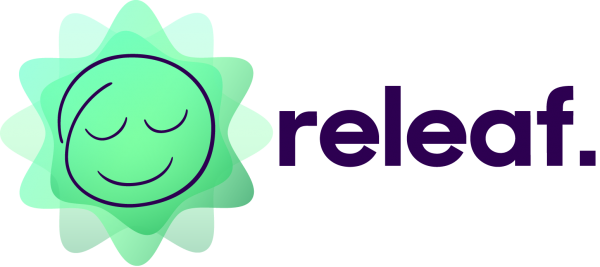Releaf examines the relationship between cannabis and anxiety and asks whether cannabis can be used to treat anxiety.

The following is an article produced by a contributing author. Growers Network does not endorse nor evaluate the claims of our contributors, nor do they influence our editorial process. We thank our contributors for their time and effort so we can continue our exclusive Growers Spotlight service.
Disclaimer
This article was originally published on the Releaf App blog. Click here if you would like to read the original article.
Depending on who you ask, the term anxiety could be viewed as taboo or a sign of weakness. Sadly, these perceptions can perpetuate a shameful stigma which is one of the primary reasons why fewer than 40% of adults with anxiety disorders seek out treatment. With estimates of nearly 40 million Americans impacted each year, it is fair to say that Anxiety Disorders are one of the most common mental illnesses in the United States.
What is Anxiety?
While there are a vast array of anxiety classifications and derivations, there are five “groups” of anxiety disorders that are the most common. According to the U.S Department of Health and Human Services, they are as follows:
- Generalized Anxiety Disorder, abbreviated as GAD, is an anxiety disorder characterized by chronic anxiety, exaggerated worry, and tension, even when there is little or nothing to provoke it. Individuals affected by GAD experience higher amounts of stress even for experiences they are familiar with.
- Obsessive-Compulsive Disorder, abbreviated as OCD, is an anxiety disorder and is characterized by recurrent, unwanted thoughts (obsessions) and/or repetitive behaviors (compulsions). Repetitive behaviors such as hand washing, counting, checking, or cleaning are often performed with the hope of preventing obsessive thoughts or making them go away. Performing these so-called “rituals,” however, provides only temporary relief, and not performing them markedly increases anxiety.
- Panic Disorder is an anxiety disorder that is characterized by unexpected and repeated episodes of intense fear (or panic) accompanied by physical symptoms that may include chest pain, heart palpitations, shortness of breath, dizziness, or abdominal distress. Individuals with Panic Disorder may have one or several rituals that can calm them, but severe cases may require hospitalization and monitoring.
- Post-Traumatic Stress Disorder, abbreviated as PTSD, is an anxiety disorder that can develop after exposure to a terrifying event or ordeal (a “trauma”) in which grave physical harm occurred or was threatened. Traumatic events that may trigger PTSD include violent personal assaults, familial abuse, natural or human-caused disasters, accidents, or military combat. PTSD was described in the first World War as “shell shock,” but it is not exclusive to combat veterans.
- Social Phobia (or Social Anxiety Disorder), is an anxiety disorder characterized by overwhelming anxiety and excessive self-consciousness in everyday social situations. Social phobia can be limited to only one type of situation – such as a fear of speaking in formal or informal situations, or eating or drinking in front of others – or, in its most severe forms, may be so broad that a person experiences symptoms almost anytime they are around other people. Social Phobia may afflict both extroverts and introverts.
Editor’s Note: Many people colloquially conflate pedantry with OCD. However, OCD is significantly more persistent and can debilitate sufferers from carrying out normal activities as they focus intensely on something that bothers them to the exclusion of other real issues.
As we mentioned before, not all anxiety sufferers seek out treatment, but there are proven treatment options available. Common treatment plans will include some form of Cognitive Behavioral Therapy (CBT) and may also incorporate prescription pharmaceuticals. There are several classes of medication that can be prescribed for anxiety disorders, and the most common classes are:
- SSRIs (selective serotonin reuptake inhibitors)
- SNRIs (serotonin-norepinephrine reuptake inhibitors)
- Benzodiazepine
If you would like to take a deeper look into the medications listed above, please visit this link to learn more about the possible side effects of taking each “class”. Remember, these are prescription drugs, so if you have any questions or concerns, always consult with your doctor before making any changes to your current treatment plan.
Is Cannabis a Treatment Option?
When it comes to anxiety medications, the pros do not always outweigh the cons. Anxiety sufferers may turn to medical cannabis as a possible treatment option. While there is still more work to be done, the current body of research indicates that medical cannabis might be a viable treatment option for patients that have been diagnosed with an anxiety disorder. To learn more about applying for a medical cannabis license in your state, please visit the “Resources for Patients” on the Americans for Safe Access website.
Medical cannabis, an underutilized treatment option, is slowly making its way onto the scene as a legitimate treatment option for insomnia patients. In the past, there was anecdotal evidence speaking to this effect, but we now have mounting scientific evidence documenting the efficacy of medical cannabis as a possible form of treatment for insomnia. Insomnia is a symptom of anxiety disorders, and shows efficacy there.
In early July, the Releaf App team contributed to the body of research by co-publishing a peer-reviewed article with a talented team of researchers at the University of New Mexico. The study, which analyzed anonymous aggregated data from Releaf patients’ insomnia sessions, found that there was an average symptom severity reduction of -4.5 points on a 0-10 point scale when patients used cannabis to help them fall asleep. The study also found that pipes and vaporizers were associated with greater symptom relief and more positive side effects than joints. Furthermore, sessions during which Cannabis indica flower was smoked or vaped resulted in fewer context-specific negative side effects than sessions with Cannabis sativa.
Editor’s Note: However, bear in mind cannabis is not a panacea. Some users have reported experiencing increased anxiety when using cannabis. This may be a result of anxiety surrounding the legal repercussions of cannabis or other external factors, or it may be internal to the user. Always make sure to try before you buy, so to speak.
Join the Releaf Anxiety Study!
If you are interested in anonymously contributing to our anxiety research, please download The Releaf App for free in the Google or iTunes Store today. Patients can join our research group by typing in the following group code in the app: “releaf4anxiety”.
10 Best Gift Ideas for Cannabis Connoisseurs and Growing Aficionados (2022)
December 7, 2022Developing and Optimizing a Cannabis Cultivation System
December 14, 2021Dealing with Insomnia: How Can CBD Help?
December 10, 2020Your Guide to Sleep and CBD
December 7, 2020
Do you want to receive the next Grower's Spotlight as soon as it's available? Sign up below!
Resources:
- Want to learn more about subjects similar to those touched upon in this article? Check out our articles on subjects such as:
- Want to get in touch with Releaf? They can be reached via the following methods:
- Website: https://releafapp.com/
- Email: contact@releafapp.com

Do you have any questions or comments?

About the Author
For us, Releaf is personal. Created with founder Franco Brockelman’s mother in mind, Releaf was designed under the basic principle that there had to be a better way to track and demystify the world of medical cannabis; a process which can be hard to navigate for experienced users, let alone people who are new to their course of treatment.